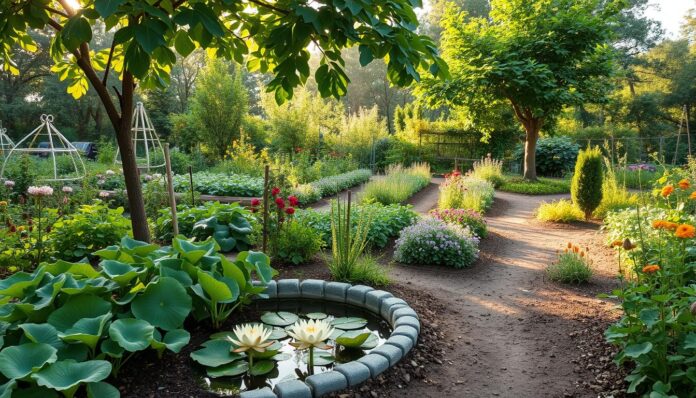Every garden has a story of connection. It’s a dance between human intention and nature’s wisdom. When I started in sustainable agriculture, I learned permaculture was more than growing plants. It’s about building a deep bond with the earth.
Permaculture is not just a gardening method. It’s a way to understand the whole ecosystem. Gardeners learn from nature’s patterns to create landscapes that are both productive and healthy. It starts with carefully watching how things are connected and work together.
With permaculture, even small spaces can become thriving ecosystems. Whether you have a tiny balcony or a big backyard, you can create gardens that are strong and work well with nature. These practices help anyone grow gardens that are both productive and good for the environment.
Key Takeaways
- Permaculture integrates mindful observation of ecological patterns
- Sustainable gardening can increase food production by 40-60%
- Mindful practices reduce water usage up to 50%
- Gardens can improve ecosystem health through intentional design
- Permaculture principles are applicable beyond traditional gardening
Understanding Permaculture and Mindful Gardening
Permaculture is a new way to design homes and gardens that are good for the planet. It uses nature as a guide. This approach helps us understand and care for our environment in a deep way.
Definition of Permaculture
Permaculture started in Australia in the 1970s. It’s a way to make living spaces that are kind to the earth. It’s based on three main values:
- Earth care
- People care
- Fair share
The Philosophy of Mindful Gardening
Mindful gardening is about being aware and connected to nature. It turns gardening into a peaceful activity. Gardeners learn to listen and respond to their garden’s needs.
“Permaculture is not just about gardening, it’s about creating intelligent designs that work with nature, not against it.”
Benefits of Combining Permaculture with Mindfulness
Using permaculture and mindfulness together has many benefits:
- Stronger ecosystems
- Less harm to the environment
- Healthier gardeners
- More food that’s good for us and the planet
Gardeners who follow these principles can make spaces that are full of life. These spaces support both people and local wildlife.
The Principles of Permaculture
Permaculture is a way to garden that connects us with nature. It was started in the 1970s by Bill Mollison and David Holmgren. This method helps us design gardens that are good for the planet.
At its heart, permaculture is about understanding nature’s systems. By following certain principles, gardeners can make their spaces better, stronger, and more fruitful.
Observe and Interact
The first rule of permaculture is to observe before acting. Gardeners spend time getting to know their environment. They learn its natural patterns and what it needs. This can take a whole year of careful planning.
- Study local climate patterns
- Analyze soil composition
- Identify native plant species
- Understand microclimate variations
Catch and Store Energy
Permaculture is all about using natural resources wisely. This rule is about finding ways to use energy well in the garden.
| Energy Capture Method | Benefits |
|---|---|
| Rainwater Collection | Reduces water consumption by up to 60% |
| Solar Design | Maximizes natural heating and lighting |
| Composting | Transforms organic waste into nutrient-rich soil |
Produce No Waste
The last rule is about making systems where waste doesn’t exist. By seeing waste as a chance to create something new, gardens can cut waste by 80%.
“In nature, there is no waste – only continuous transformation.” – Bill Mollison
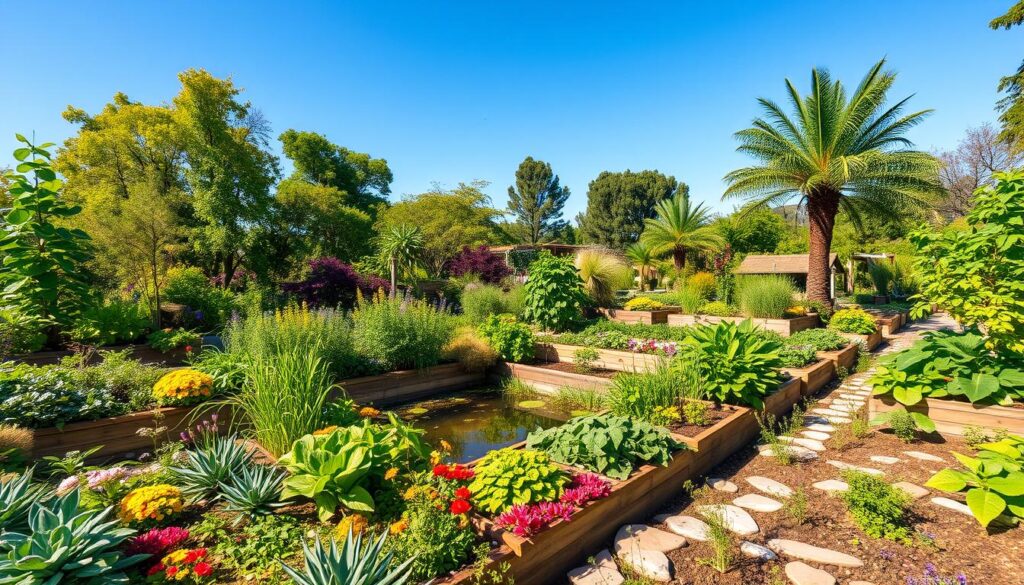
By using these principles, gardening becomes a way to work with nature, not against it. It’s a sustainable and thoughtful way to garden.
Designing a Mindful Garden
Creating a thoughtful garden space needs careful planning and design. Permaculture offers a holistic approach. It transforms outdoor spaces into productive, sustainable ecosystems. These spaces reflect both environmental harmony and personal creativity.
Designing a mindful garden starts with understanding your unique space. It’s about food forestry and closed-loop systems. Successful garden design focuses on creating interconnected, self-sustaining environments.
Assessing Your Garden Space
Effective garden design begins with thorough observation. Spend time understanding your landscape’s unique characteristics:
- Analyze sunlight patterns throughout the day
- Evaluate soil composition and drainage
- Identify existing plant communities
- Observe wildlife interactions
Creating a Permaculture Design Map
Developing a comprehensive garden map helps visualize potential interactions. Consider the following design principles when mapping your space:
| Design Element | Consideration |
|---|---|
| Zones | Organize areas based on frequency of use and maintenance |
| Sectors | Analyze external influences like wind, sun, and water flow |
| Microclimates | Identify unique environmental conditions within your garden |
Applying Mindfulness in Garden Design
Integrating mindfulness into garden design transforms the space into a regenerative ecosystem. Approach your design with intention. Pay attention to each element’s potential interactions and multifunctional roles.
“In permaculture, we view our garden as a living system, not just a collection of plants.”
By embracing these principles, gardeners can create resilient, productive spaces. These spaces support both human needs and ecological balance.
Soil Health and Mindful Gardening
Healthy soil is key to sustainable agriculture and thriving permaculture gardens. By applying biomimicry, gardeners connect deeply with their garden’s ecosystem.
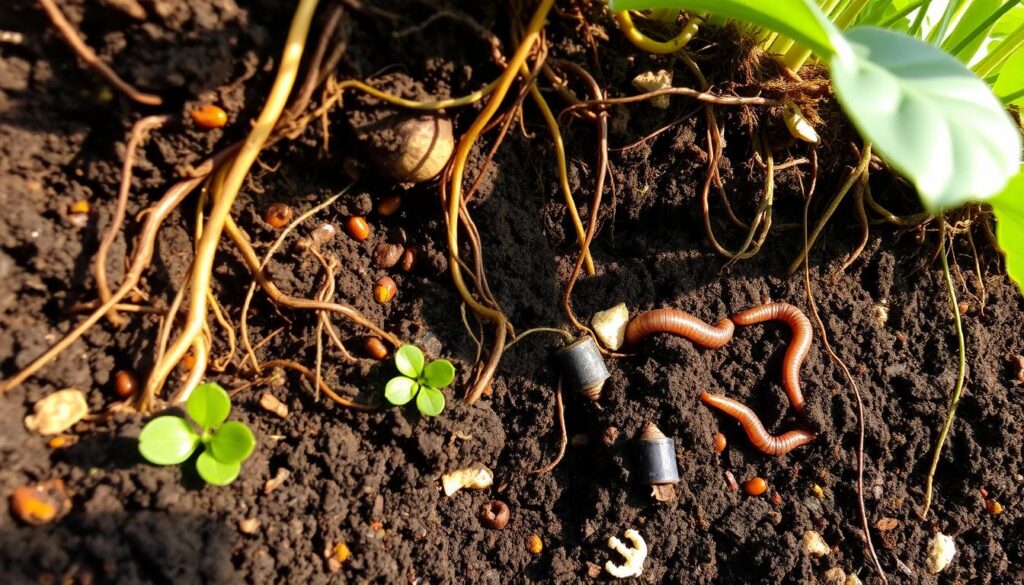
Soil quality affects plant health, water retention, and garden productivity. It’s a living system that supports microorganisms. These help plants grow strong and cycle nutrients.
Importance of Soil Quality
Soil health is more than just nutrients. Gardens using permaculture can cut down on external inputs by 50%. This is thanks to self-sufficiency.
- Enhances plant nutrient absorption
- Improves water retention capabilities
- Supports beneficial microbial communities
- Increases overall garden ecosystem resilience
Techniques for Soil Improvement
There are many ways to improve soil through sustainable agriculture. Composting and mulching are powerful methods. They build soil health without chemicals.
- Implement no-till gardening methods
- Use organic compost regularly
- Apply natural mulching techniques
- Integrate cover crops
Mindfulness Practices for Soil Stewardship
“Soil is not just dirt; it’s a living, breathing ecosystem that connects us to the broader natural world.”
Mindful gardeners see soil stewardship as a whole practice. They observe soil, understand microbes, and adapt to changes. This way, they create gardens that support biodiversity and plant health.
By using biomimicry, gardeners work with nature. They build sustainable, resilient gardens. These gardens thrive through careful, connected management.
Water Management in Permaculture
Water is essential for any garden, playing a key role in sustainable gardening. Permaculture views water management as a closed-loop system. This changes how we use this vital resource.
Water conservation needs a big-picture view. Our planet has only 2.5% of its water available for us. Permaculture gardeners can make a big difference with smart water management.
Collecting Rainwater
Rainwater harvesting is a great way to cut down on water use. Key steps include:
- Installing rain barrels at drainage points
- Creating swales with specific gradient designs
- Developing rain gardens to capture runoff
Efficient Irrigation Techniques
New irrigation methods can cut down water waste a lot. Drip irrigation and mulching can save up to 30% of water. This makes gardens more drought-tolerant.
- Drip irrigation delivers water directly to plant roots
- Mulching reduces evaporation
- Contouring landscape to slow water runoff
The Mindfulness of Water Use
Water management is more than just tech. It’s about being mindful of nature’s cycles and water’s value. By knowing local watersheds, gardeners can make landscapes more water-efficient.
“Water is the driving force of all nature.” – Leonardo da Vinci
Using these design principles turns water into a key player in garden ecosystems. It creates closed-loop systems that support both plants and the environment.
Plant Selection for Mindful Gardens
Creating natural ecosystems in your garden needs careful plant choice. Holistic gardening is more than just looks. It’s about building plant communities that help local wildlife thrive.
Choosing Native Plants
Native plants are key for green gardening. They bring big benefits:
- They fit well with local weather
- They need little care
- They help local animals and bees
- They use less water
Companion Planting Strategies
Pairing plants wisely can make your garden better and stronger. Here are some tips:
| Plant Combination | Benefit |
|---|---|
| Tomatoes + Basil | Pest deterrence |
| Carrots + Onions | Pest control |
| Beans + Corn | Nitrogen fixation |
Creating Biodiversity
Biodiversity turns gardens into strong, self-supporting places. Include perennial veggies, fruit trees, berry bushes, and many herbs for a lively, fruitful space.
“In nature, diversity is strength. The same principle applies to our gardens.” – Permaculture Wisdom
Pest Management through Permaculture
Ecological landscaping turns pest problems into chances for green farming. It shows how insects, plants, and ecosystems work together. This approach helps manage gardens in a complete way.
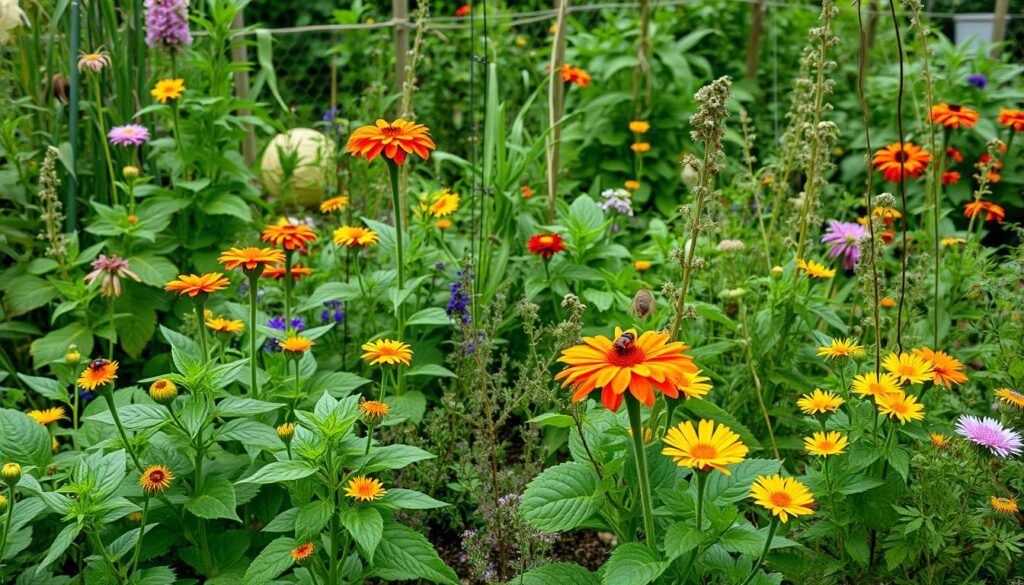
Permaculture changes how we see pests. It sees garden creatures as part of a team, not enemies. Healthy places have many different life forms, each helping to keep things balanced.
Natural Pest Control Methods
- Encourage beneficial insect populations
- Use companion planting strategies
- Create physical barriers for pest protection
- Promote habitat diversity
Mindful Observation of Pest Activity
Watching pests closely shows us amazing connections. For example, caterpillars eat plants but then become important pollinators like butterflies. Knowing these links helps us avoid quick fixes.
| Pest | Ecological Role | Beneficial Interactions |
|---|---|---|
| Aphids | Plant nutrient consumers | Food source for Hoverfly larvae |
| Fire Ants | Soil ecosystem engineers | Improve soil water absorption |
| Blue Mud Dauber Wasp | Predatory insect | Controls black widow spider populations |
Creating a Balanced Ecosystem
Green farming grows when we accept complexity. By supporting many species, we can control pests naturally. This way, we avoid harmful methods.
“In nature, every organism has a purpose. Pests are not enemies, but participants in a complex ecological dance.”
Strong, healthy plants fight off pests better. Studies show that well-fed plants are more resistant to threats.
Seasonal Gardening in Alignment with Nature
Permaculture gardening connects deeply with nature’s cycles. Gardeners use seasonal patterns to create designs that work with nature.
Good gardening means watching and adapting to nature’s changes. Biomimicry shows us to follow nature’s smart design. This way, gardens grow well with careful seasonal care.
Understanding Seasonal Rhythms
Every season offers its own gardening challenges and chances. Key parts of seasonal knowledge include:
- Tracking local temperature changes
- Watching rainfall patterns
- Noticing changes in daylight
- Seeing how native plants react
Mindful Practices for Seasonal Change
“Nature does not hurry, yet everything is accomplished.” – Lao Tzu
Adjusting to seasonal changes needs patience and careful watching. Gardeners can follow mindful steps by:
- Keeping records of plant growth
- Changing care routines
- Keeping plants safe in harsh times
- Enjoying each season’s special gifts
Crop Rotation Benefits
Crop rotation follows nature’s cycles, helping soil and keeping nutrients balanced. Research shows permaculture can grow 20-30% more food per hectare than regular farming.
By following seasonal rhythms and using regenerative design, gardeners make strong, fruitful ecosystems. These systems respect nature’s wisdom.
Composting as a Mindful Practice
Composting is a key part of sustainable gardening. It turns waste into something useful for gardens. Gardeners make rich soil and help the environment.
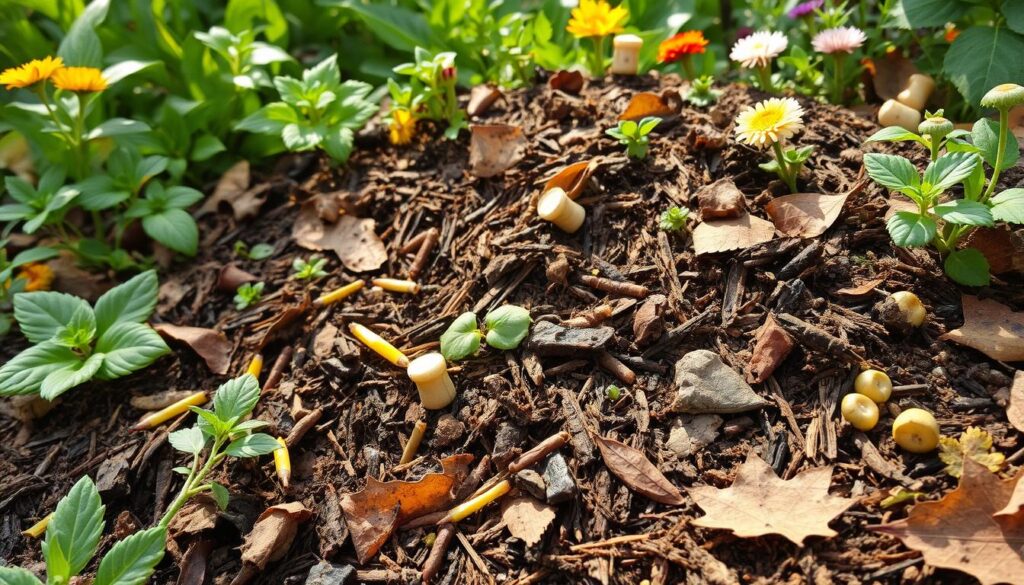
Composting is more than just getting rid of trash. It’s a way to connect with nature’s cycles. It shows how we can work with nature, not against it.
The Benefits of Composting
- Enriches soil with essential nutrients
- Reduces waste sent to landfills
- Supports carbon sequestration
- Promotes sustainable agriculture practices
Steps to Start Composting
- Select a suitable location for your compost pile
- Gather organic materials
- Create layers of green and brown materials
- Maintain proper moisture levels
| Material Type | Examples | Composting Value |
|---|---|---|
| Green Materials | Kitchen scraps, grass clippings | Nitrogen-rich |
| Brown Materials | Dry leaves, cardboard | Carbon-rich |
Mindful Compost Maintenance
Composting needs patience and watching closely. Regular turning helps it break down right. It keeps it from smelling bad. It’s all about finding the right mix of materials.
“Composting is nature’s way of recycling, transforming waste into life-giving soil.” – Permaculture Wisdom
By composting, gardeners help nature. They turn waste into something good for the earth.
The Role of Pollinators in Your Garden
Pollinators are the unsung heroes of natural ecosystems. They play a critical role in maintaining biodiversity and food production. These tiny creatures are essential to the health and productivity of holistic gardening practices. They ensure the reproduction of countless plant species.
Understanding the importance of pollinators reveals their incredible impact on our world. Consider these remarkable statistics:
- Pollinators are responsible for approximately 1 in every 3 bites of food consumed globally
- About 75% of global food crops depend on pollinators for reproduction
- Around 80% of flowering plants require animal pollinators to reproduce effectively
Importance of Pollinators in Garden Ecosystems
In holistic gardening, pollinators are more than just visitors – they are essential partners. Bees, butterflies, wasps, and other insects contribute to crop production worth billions of dollars annually. Their work goes beyond economic value, supporting the intricate balance of natural ecosystems.
Creating a Pollinator-Friendly Environment
Designing a garden that supports pollinators requires strategic planning. Key strategies include:
- Plant diverse native flowering species
- Provide water sources
- Avoid chemical pesticides
- Create sheltered areas for nesting
Mindfulness in Supporting Pollinators
Mindful gardeners recognize the delicate relationship between plants and pollinators. By observing and supporting these creatures, we can create thriving garden environments. These environments benefit both wildlife and human communities.
“In every walk with nature, one receives far more than he seeks.” – John Muir
| Pollinator Type | Key Contributions | Preferred Plants |
|---|---|---|
| Bees | Primary crop pollinators | Lavender, Sunflowers, Borage |
| Butterflies | Pollinate diverse flowering plants | Marigolds, Chamomile, Bee Balm |
| Hoverflies | Support ecosystem diversity | Dandelions, Dahlias |
Integrating Edible Plants into Mindful Gardens
Food forestry is a new way to grow food that’s good for the planet. It mixes nature with gardens that give us food. People who love permaculture are using this method to make gardens that are both useful and pretty.
To make an edible garden, you need to plan carefully. The American Society of Landscape Architects says more people want gardens that are green and self-sufficient.
Choosing Edibles for Your Space
When picking plants for your garden, think about a few things:
- Local climate conditions
- Available sunlight
- Soil type and quality
- Space limitations
Experts say to pick plants that are native to your area. They fit well with the local environment and need less care.
Mindful Harvesting Techniques
“Harvest with respect and intention, understanding that each plant is part of a larger ecosystem.”
Harvesting food in a way that’s good for the planet means:
- Watching how plants are doing
- Using clean, sharp tools
- Picking food when it’s best
- Not taking too much so plants can grow back
Cooking and Eating from Your Garden
Growing your own food helps you feel connected to nature. The Permaculture Research Institute says eating food from your garden makes you healthier and helps the planet.
| Vegetable | Growing Difficulty | Space Requirement |
|---|---|---|
| Tomatoes | Easy | Small container/raised bed |
| Squash | Moderate | Large garden space |
| Cucumbers | Easy | Vertical trellis |
| Peppers | Easy | Small container |
By adding edible plants to your garden, you make a space that’s alive and gives you food. It also helps the planet by following green farming ways.
Community and Connection through Gardening
Permaculture is more than just growing plants. It’s a way to connect people through holistic gardening. It helps communities grow stronger by sharing knowledge and working together.
Building Vibrant Community Gardens
Starting with community gardens is key to building strong communities. These gardens thrive when everyone works together. They follow important steps:
- Create inclusive planning processes
- Develop shared decision-making frameworks
- Establish clear communication channels
- Design flexible participation models
Shared Gardening Practices
Knowledge sharing is at the heart of community gardening. Local groups use many ways to share and learn together. For example:
- Seed swapping events
- Skill-sharing workshops
- Communal harvest celebrations
- Rotating garden maintenance responsibilities
“In permaculture, our gardens are not just about growing food, but growing connections.”
Mindful Gardening Relationships
Building strong relationships in gardening takes effort. It’s about respect, listening, and learning together. When people are open and curious, gardening becomes a journey of growth.
| Community Garden Element | Impact on Social Connectivity |
|---|---|
| Shared Decision Making | Increases trust and engagement |
| Skill Exchanges | Builds mutual understanding |
| Collective Problem Solving | Strengthens community bonds |
By following these principles, gardens can become more than just green spaces. They become places for connection, learning, and growth for everyone.
Visiting Your Garden: The Mindful Experience
Permaculture mindful gardening turns garden visits into deep moments of connection with nature. It’s more than just taking care of plants. It’s about building a strong bond with your garden’s ecosystem.
Having a regular garden visit schedule helps you know your garden well. Each visit is a chance to observe and interact with your garden’s living world.
Setting a Routine for Garden Visits
- Choose a specific time each day or week for garden observation
- Approach visits with intentional awareness
- Use visits to understand garden rhythms and patterns
- Track plant growth and ecosystem changes
Meditative Practices While Gardening
Adding meditation to gardening changes the experience. Mindful breathing or saying thanks during harvest makes you feel closer to your garden.
“In the garden, every moment is an opportunity for mindfulness and connection with nature’s intricate systems.”
The Importance of Mindfulness in Observation
| Observation Technique | Benefits |
|---|---|
| Sensory Awareness | Deepens understanding of garden ecosystem |
| Slow, Intentional Movement | Reduces stress, increases garden connection |
| Seasonal Pattern Recognition | Improves holistic gardening strategies |
Mindful practices help gardeners understand their garden better. This leads to a peaceful and sustainable garden environment.
Challenges in Mindful Permaculture
Sustainable agriculture and regenerative design are powerful tools. But, they come with unique challenges. These challenges test even the most dedicated practitioners. To overcome them, patience, resilience, and a deep commitment to mindful gardening are needed.
Common Obstacles and Strategic Solutions
Permaculture practitioners face big hurdles in their sustainable agriculture journey. Economic barriers are a major challenge, with about 20% of community-led projects struggling to get resources. These challenges can show up in several areas:
- Limited land access due to rising property values
- Resource allocation difficulties
- Community disruption from gentrification
- Zoning restrictions impacting ecological practices
Staying Committed to Mindfulness
Maintaining focus requires strategic approaches to regenerative design. Emotional resilience is key in overcoming challenges. Self-care practices are vital for sustained ecological engagement.
The principle of “slow and steady” reminds us that sustainable change happens gradually, not overnight.
Learning from Mistakes
Permaculture is about adaptation and growth. About 30-50% of community initiatives see challenges as chances for deeper understanding. Key strategies include:
- Seeking constructive feedback
- Embracing personal growth
- Maintaining flexible approaches
- Cultivating community support
By facing challenges with mindfulness and resilience, practitioners can turn obstacles into stepping stones. This leads to more effective sustainable agriculture and regenerative design.
The Future of Mindful Gardening and Permaculture
The world of sustainable farming is changing fast. Permaculture is becoming a key way to rethink how we grow food. Studies show that gardening can make people fitter and more mindful.
More people in cities and towns are starting to use permaculture. It’s making communities stronger and boosting self-confidence. These changes show that permaculture can do more than just grow food.
As the planet faces more problems, permaculture is a strong solution. It can cut down on pests and help people grow more food in cities. The future of farming is about working together and caring for the earth.
Permaculture is more than just gardening. It’s a way of life that connects us to the earth and each other. Gardening can give people a sense of purpose and belonging.

